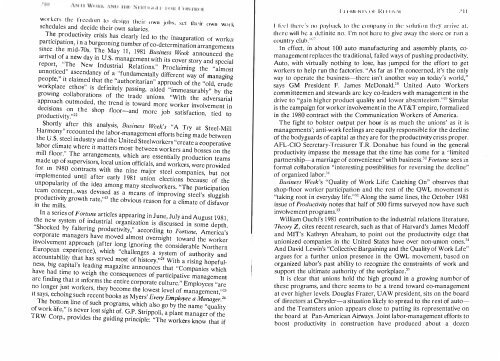CONTENTS - ouroboros ponderosa
CONTENTS - ouroboros ponderosa
CONTENTS - ouroboros ponderosa
Create successful ePaper yourself
Turn your PDF publications into a flip-book with our unique Google optimized e-Paper software.
workers the freedom to design their OWII johs, set t111'ir OWII wo rk<br />
schedules and decide their own salaries.<br />
The productivity crisis has clearly led to the inauguration of worker<br />
participation : in a burgeoning number of co-determination arrangements<br />
smce the mId-70s. The May 11, 1981 Business Week announced the<br />
arrival of a new day in U.S. managcment with its Cover story and spccial<br />
report, "The New Industrial Relations." Proclaiming the "almost<br />
unnoticed" ascendancy of a "fundamentally differcnt way of managing<br />
people," it claimed that the "authoritarian" approach of the "old, crude<br />
workplace ethos" is definitely passing, aided "immeasurably" by the<br />
growmg collaboratIons of the trade unions. "With the adversarial<br />
approach outmoded, the trend is toward morc worker involvement in<br />
decisions on the shop floor-and morc job satisfaction tied to<br />
productivity., , 22<br />
Shortly after this analysis, Business Week's "A Try at Steel-Mill<br />
Harmony" recounted the labor-management efforts being made between<br />
the U.S: steel industry and the United Steelworkers "create a cooperative<br />
labor ehmate where It matters most: between workers and bosses on the<br />
mill floor." The arrangements, which are essentially production teams<br />
made up of supervisors, local union officials, and workers, were provided<br />
tor In 1980 contracts WIth the nine major stcel companies, but not<br />
Implemented untIl after early 1981 union elections because of the<br />
unpopularity of the idea among many steelworkers. "The participation<br />
tcam concept...was deVIsed as a mcans of improving steel's sluggish<br />
productivity growth rate,"" the obvious reason for a climate of disfavor<br />
in the mills.<br />
In a series of Fortune articles appearing in June, July and August 1981,<br />
the ncw system of industrial organization is discussed in some depth.<br />
"Shocked by faltering productivity," according to For/une, America's<br />
corporate managers have moved almost overnight toward the worker<br />
involvement approach (after long ignoring the considerable Northern<br />
European xperience), which "challenges a system of authority and<br />
accountabIlI tat has served most of history."" With a rising hopeful<br />
ness, bIg capItal s leadmg magazme announces that "Companies which<br />
have . had time to weigh the consequences of participative management<br />
arc fIndIng that It mforms the entire corporate culture." Employees "are<br />
no longer Just workers, they become the lowest level of management,""<br />
It says, echomg . such recent books as Myers' Every Employee a Manager. 26<br />
The bott0?,l . hne of such programs, which also go by the name "quality<br />
of work hfe, IS ne er lost SIght of. G.P. Strippoli, a plant manager of the<br />
TR W Corp., proVIdes the guiding principle: "The workers know that if<br />
.<br />
'<br />
1 '.I I · MI ·N I .... I 11- RI' I 11 .... .-\1 !II<br />
I kl'l t1H'I"l" s IHl pay hack. lo the cOllipany ill thl' sulutiun IhlY arrive at,<br />
there will he. a lil.:finitc no. I'm not here to give away the store or rlln a<br />
countIy club."'" .<br />
In effect in about 100 auto manufactUrIng and assembly plants, co<br />
managemct replaces thc traditional, failed ways of ushing productivity.<br />
Auto with virtually nothing to lose, has Jumped tor the effort to get<br />
workrs to help run the factories. "As far as I'm concerned, it' : the anI;:<br />
way to operatc the business-there isn't another way In today's world,<br />
says GM President F. James McDonald.28 United Auto Workers<br />
committeemen and stewards arc kcy co-leaders WIth man gen;t n the<br />
drivc to "gain higher product quality and lower absentee sm. SImIlar<br />
is the campaign for workcr involvement in the AT &T empIre, for ahzed<br />
in the 1980 contract with the Communication Workers of America.<br />
The fight to bolster output per hour is as much the unions' as it is<br />
managements'; anti-work feelings are equally responSIble tor the declIne<br />
of the bodyguards of capital as thcy are for the prodUCtIVIty ens IS proper.<br />
AFL-CIO Secrctary-Treasurer T.R. Donahue has found III the enral<br />
productivity impasse the message that the time has come for a . lImIted<br />
partnership-a marriage of convcnien<br />
<br />
e' ' ith<br />
business.30 Fortune ses l<br />
. .<br />
.<br />
formal collaboration "interesting pOSSIbIlItIes for reversmg the dcehne<br />
]I<br />
of organized labor.<br />
Business We ek's "Quality of Work Life: Catching On" observes that<br />
shop-tloor worker participatio and the rest of the QWL movement IS<br />
"taking root in everyday life."L Along the same lInes, the October 1981<br />
issue of Productivity notes that half of 500 firms surveyed now have such<br />
. I<br />
33<br />
IllVO vement programs.<br />
. . .<br />
William Ouchi's 1981 contribution to the industnal relatIons hterature,<br />
Theory Z, cites recent research, such as that of Harvard's James Medoff<br />
and MIT's Kathryn Abraham, to point out the productIVIty edge th!<br />
unionized companies in thc United States have over non-umon ones.<br />
And David Lewin's "Collective Bargaining and the QualIty at Work LIte "<br />
argues for a further union presence in the QWL movement, based on<br />
organized labor's past ability to recogmze thc C?nstramts of work and<br />
slIpport the ultimate authority of the workplace "<br />
: .<br />
It is clear that unions hold the high ground III a growIllg number of<br />
these programs, and there seems to be a trend toward co-management<br />
at ever hicrher levels. Douglas Frazer, UAW president, sits on the board<br />
of directos at Chrysler-a situation likely to spread to the rest of a . uto<br />
and the Teamsters union appears close to putting its representatIve on<br />
the board at Pan-American Airways. Joint labor-management efforts to<br />
boost productivity in construction have produced about a dozen






